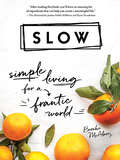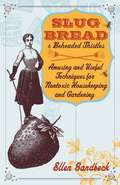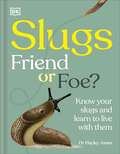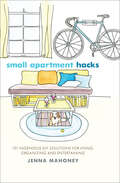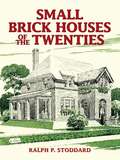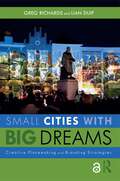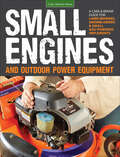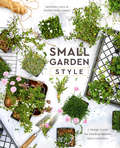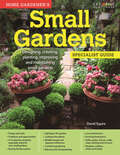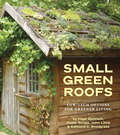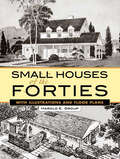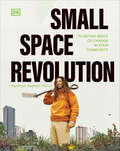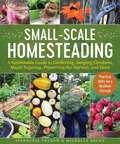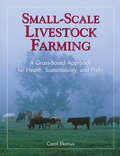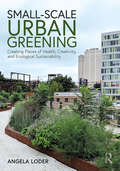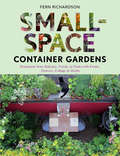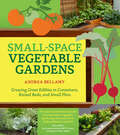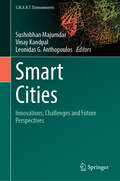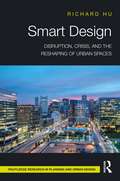- Table View
- List View
Slow: Finding Peace and Purpose in a Hectic World
by Jo PetersEndless work deadlines, family and social responsibilities, runaway to-do lists, FOMO… do you ever wish you could press the pause button to catch a breath?Discover ways to slow down time with this invaluable guide to slow living. It will not only boost your physical and mental well-being but enrich your relationships and help you to reconnect with what’s really important.With practical advice on self-care, breathing techniques, mindfulness, ethical living and eating, and how best to cultivate quiet moments every day, Slow is your companion to a happier, calmer you.
Slow: Simple Living for a Frantic World
by Brooke McAlaryFree yourself from the frantic and embrace the joy of slow..."After reading this book, you'll have an amazing list of ingredients that can help you create a meaningful life, too!" —The Minimalists Joshua Fields Millburn and Ryan Nicodemus"Finally, a slow living guide for the imperfect folks . . . Brooke McAlary's exuberant, honest words are a refreshing contribution to the slow living community. If you're seeking a simpler path, start here." —Erin Loechner, Blogger at DesignforMankind.com and author of Chasing SlowAre you constantly striving to keep up with life's busy expectations? It's easy to feel consumed with the desire to "succeed" and "acquire", and miss the simple opportunities waiting for you to slow down: a walk in the forest, sharing laughter with family, a personal moment of gratitude...Once upon a time, it became clear to Brooke McAlary that the key to happiness was discovering a simpler, more fulfilling existence. She put the brakes on her stressful path, and reorganized her life to live outside the status-quo, emphasizing depth, connection and meaningful experiences. Alongside Brooke's affirming personal stories of breaking down and rising up, Slow provides practical advice and fascinating insights into the benefits and challenges of the slow life, such as: —Decluttering to de-owning—Messiness to mindfulness—Asking why, to asking where to now?Slow is an inspirational guide on creating a life filled with the things that really matter, and is meant for anyone seeking peace, meaning, and joy in their otherwise rapid lives. Slowly—of course.
Slug Bread and Beheaded Thistles: Amusing and Useful Techniques for Nontoxic Housekeeping and Gardening
by Ellen SandbeckOff with their heads! Many homemakers and gardeners take the easy way out when it comes to exiling odors and banishing bugs--they use toxic chemicals that may be harmful to their families and the earth. Ellen Sandbeck has discovered that the all-natural alternatives are just as easy and effective to use, and that they are wickedly fun. Sandbeck's way of banishing thistles from her backyard kingdom is a case in point: she chops off their heads and lets them bleed to death. Slug Bread & Beheaded Thistlesreveals all of her best tricks. From bedroom to bathroom, garden to lawn, your home will be clean and green and pest-free. Explode cockroaches with baking soda and sugar Freshen your car with coffee grounds Keep out slugs with a bread dough that kills Armor your plants with soap spray Grow disease-resistant plants by putting sick ones in your compost pile Eradicate crayon marks with mayonnaise Protect your roses with a minefield of garlic Get rid of raccoons with dirty laundry Cure plant viruses with spoiled milk
Slugs: Know Your Slugs and Learn to Live with Them
by Royal Horticultural SocietyAre slugs and snails wreaking havoc in your garden? Do you want to nip the problem in the bud but don't know how without resorting to harmful pesticides?Every gardener shares the same struggle. But what if not all slugs deserve the bad rap in your garden?Discover everything you need to know about slugs: the different species, their fascinating life cycles, and the important role they play in your garden ecosystem. Learn which slugs are busy recycling decaying matter and which ones have your precious seedling firmly on their menus, as well as the practical steps you can take to control them with eco-friendly measures.Think you know slugs? Think again. Let the experts help you become friends with mollusks with Slugs: Friend or Foe?
Small Apartment Hacks: 101 Ingenious DIY Solutions for Living, Organizing and Entertaining
by Jenna MahoneyHelpful tips, space-saving tricks, and DIY projects to help make a shoebox apartment beautifully functional. This handy guide enables readers to transform their tiny, shoebox apartment into a welcoming, delightful and adorable abode. The author&’s advice gives anyone the chance to have a stylish, space-savvy home by showing how to take advantage of every nook and cranny. Whether it&’s maximizing floor space with furniture arrangements like a lofted bed above a work area or inventive storage solutions like a dining table that stashes dishes, there is no space too small to be made posh by Small Apartment Hacks. LIVE LARGE • Hang hobby clutter like guitars or bikes on the wall as decoration • Mount side tables on wheels for easy rolling from bedside to sofa ORGANIZE SMART • Upcycle empty wine crates into stylish, stackable shoe cubbies • Line a room with high bookshelves for a ceiling-top library ENTERTAIN IN STYLE • Utilize kitchen space to make an impressive entrée—go potluck on the sides • Stash plants, lamps, and coffee tables in the bathtub to open up party space&“Heed Jenna Mahoney&’s advice. In her new book, Small Apartment Hacks, she dishes out genius ideas for optimizing tiny spaces.&” —Daily Candy
Small Brick Houses of the Twenties
by Ralph P. StoddardOnce affordable only among the wealthy, brick homes became more easily available to the average American in the early years of the twentieth century. This book, originally published in 1920 by a member of The Common Brick Manufacturers' Association, served as a practical guide for prospective homeowners from working class families. Many soon found that attractive, durable, and comfortable homes--made from nature's own building material--were easily within their financial reach. <p><p> Thirty-five sets of floor plans, elevations, and specifications in this excellent reproduction of that now-rare volume depict a wide variety of brick houses, bungalows, cottages, garages, and multi-dwelling buildings--from the four-bedroom Pocatello to the handsome Saratoga, featuring a wraparound porch and two bathrooms. This practical guide will appeal to anyone wanting to buy or renovate an existing home of the period. It will also serve as a how-to manual for all desiring to build their own homes today with authentic materials and techniques. For those who love fine, old buildings, Small Brick Houses of the Twenties offers a charming view of American homes from that era.
Small Cities with Big Dreams: Creative Placemaking and Branding Strategies
by Greg Richards Lian DuifHow can small cities make an impact in a globalizing world dominated by ‘world cities’ and urban development strategies aimed at increasing agglomeration? This book addresses the challenges of smaller cities trying to put themselves on the map, attract resources and initiate development. Placemaking has become an important tool for driving urban development that is sensitive to the needs of communities. This volume examines the development of creative placemaking practices that can help to link small cities to external networks, stimulate collaboration and help them make the most of the opportunities presented by the knowledge economy. The authors argue that the adoption of more strategic, holistic placemaking strategies that engage all stakeholders can be a successful alternative to copying bigger places. Drawing on a range of examples from around the world, they analyse small city development strategies and identify key success factors. This book focuses on the case of ‘s-Hertogenbosch, a small Dutch city that used cultural programming to link itself to global networks and stimulate economic, cultural, social and creative development. It advocates the use of cultural programming strategies as a more flexible alternative to traditional top-down planning approaches and as a means of avoiding copying the big city. The Open Access version of this book, available at http://www.taylorfrancis.com, has been made available under a Creative Commons Attribution-Non Commercial-No Derivatives (CC-BY-NC-ND) 4.0 license.
Small Engines and Outdoor Power Equipment: A Care & Repair Guide for: Lawn Mowers, Snowblowers & Small Gas-Powered Implements
by Peter Hunn“Small engine repair and maintenance is well covered. . . . larger instructional photos are a highlight . . . the organization is insightful . . . highly recommended.” —Library Journal, starred reviewThis book is more than a simple engine repair manual. Designed for the beginner with little or no mechanical experience, Small Engines & Outdoor Power Equipment is a graphically appealing, step-by-step guide that covers all of the most important engine maintenance and repair skills you’ll need to keep your equipment running at peak performance. It also shows exactly how to perform mechanical upkeep and repairs on the most common outdoor power implements, including lawn mowers, snow blowers, chain saws, power washers, generators, leaf blowers, rototillers, wood splitters, lawn edgers, and weed whips. With clear ‘how-to’ photos and detailed diagrams, you’ll see exactly what needs to be done. A comprehensive troubleshooting guide helps you define problems and enact solutions. With Small Engines & Outdoor Power Equipment in your library, you won’t need to haul the lawn mower off to the repair center and wait a few weeks just because a filter is plugged or the old gas needs to be replaced. Among the many skills you’ll learn are seasonal tune-ups, changing oil, servicing spark plugs, cleaning filters, replacing muffler, servicing the fuel tank, overhauling the carburetor, servicing brakes, inspecting flywheels, replacing the fuel pump, and replacing a rewind cord.
Small Garden Style: A Design Guide for Outdoor Rooms and Containers
by Isa Hendry Eaton Jennifer Blaise KramerA stylishly photographed guide to creating lush, layered, dramatic little gardens no matter the size of your available space--an urban patio, a tiny backyard, or even just a pot by your door.Petite gardens align with the movement to live smaller and create a life with less stuff and more room for living. But a more eco-friendly and efficient space doesn't have to sacrifice style. In Small Garden Style, garden designer Isa Hendry Eaton and lifestyle writer Jennifer Blaise Kramer show you how to use good design to create a joyful, elegant, and exciting yet compact outdoor living space for entertaining or relaxing.A style quiz helps you focus in on your own personal garden style, be it traditional, modern, colorful, eclectic, minimalist, or globally inspired, then utilize every inch of your yard by considering the horizontal, vertical, and overhead spaces. You'll learn how to design stunning planters and container gardens using succulents, grasses, vibrant-colored pots, and more. Hendry Eaton and Blaise Kramer recommend their favorite plants and decor for small gardens, along with lawn alternatives and inspiration for making garden accents such as a fire pit, front door wreath, instant mini orchard, boulder birdbath, patterned vines, perfumed wall, and faux fountain with cascading plants. However small your garden, Small Garden Style will transform it into a magical, modern outdoor oasis.
Small Gardens: Designing, creating, planting, improving and maintaining small gardens (Home Gardener's)
by David SquireThe essential guide to improving a small garden and turning the most modest-sized space into a stunning outdoor area. Is your small garden swamped by oversized plants and in urgent need of a makeover? Have you considered adding climbing plants, containers, hanging baskets, and window boxes? The detailed guide provides space-saving designs and lists the most suitable plant combinations for small gardens, patios, and courtyards. Easy-to-use and concise reference guide Expert advice about small gardens Step-by-step instructions and practical ideas for small spaces A-Z directory of small-garden plants Pictorial survey of features for a small garden Easy maintenance ideas for looking after a small garden
Small Green Roofs: Low-Tech Options for Greener Living
by John Little Edmund C. Snodgrass Nigel Dunnett Dusty GedgeUntil now, the green roof movement has been limited to large-scale, professional endeavors and public buildings. But homeowners everywhere are catching onto the benefits of a green roof—water conservation, energy savings, and storm water management. In Small Green Roofs authors Dunnett, Gedge, Little, and Snodgrass profile ordinary homeowners who scaled green roofs down to the domestic level.Small Green Roofs is the first book to focus on small-scale and domestic green roofs. More than forty profiles of small and domestic-scale projects of all shapes and sizes include green roofs on sheds, garden offices, studios, garages, houses, bicycle sheds, and other small structures, as well as several community projects. For each project, details are given for design, construction, and installation, as well as how-to tips on how the roof was planted and cared for. For readers looking for inspiration when hiring a contractor or taking the adventurous step of building their own, Small Green Roofs provides the knowledge and encouragement to make it possible.
Small Houses of the Forties: With Illustrations and Floor Plans
by Harold E. GroupDesigned for the 1940s family with a "limited budget but unlimited good taste," this fascinating volume presents 56 floor plans and elevations of lovely small homes that originally cost less than $15,000 to build. Each home, bearing the honorable designation of House-of-the-Month by the era's Monthly Small House Club, Inc., was designed to give prospective homeowners an exceptionally well-planned house that was also a sound investment. From Cape Cods to Colonials, Small Houses of the Forties offers an eden of illustrations of cozy, charming domiciles, complete with color combinations, charts, and diagrams. This complete republication of a now-rare volume is also filled with vintage dollars-and-sense information for the postwar homebuyer, including mortgage guidance, amortization schedules, valuations, and construction costs of the times. <p><p> A nostalgic flashback to a simpler American dream of white picket fences, this entertaining and valuable reference will delight architecture enthusiasts, plan collectors, restorers, and historians alike.
Small Pleasures: Longlisted for the Women's Prize for Fiction
by Clare ChambersLONGLISTED FOR THE WOMEN'S PRIZE FOR FICTIONA BBC 2 'BETWEEN THE COVERS' BOOK CLUB PICK'Wonderful' RICHARD OSMAN'Perfect' INDIA KNIGHT'Beautiful' JESSIE BURTON'Witty and sharp' DAVID NICHOLLS1957, the suburbs of south east London. Jean Swinney is a journalist on a local paper, trapped in a life of duty and disappointment from which there is no likelihood of escape. When a young woman, Gretchen Tilbury, contacts the paper to claim that her daughter is the result of a virgin birth, it is down to Jean to discover whether she is a miracle or a fraud. As the investigation turns her quiet life inside out, Jean is suddenly given an unexpected chance at friendship, love and - possibly - happiness.'Gorgeous . . . I could not recommend it more' PANDORA SYKES'Remarkable . . . Small Pleasures is no small pleasure' THE TIMES'Irresistible . . . wry, perceptive and quietly devastating' MAIL ON SUNDAY
Small Space Living: Expert Tips and Techniques on Using Closets, Corners, and Every Other Space in Your Home
by Roberta SandenberghComplete with demonstrative illustrations and photographs, Small Space Living offers more than one hundred space-saving ideas from Roberta Sandenbergh, a.k.a the Small Space Architect.Sandenbergh will introduce you to the idea of space opportunities—untapped areas in every home that can be expanded for storage and organizational purposes. A space opportunity might be as simple as using an empty space under a stairway or above a doorway or as complicated as dividing your entire apartment for rental income.Each chapter addresses a different kind of space opportunity area, including closets, corners, walls, windows, ceilings, and floors. In these areas, you will be inspired by Sandenbergh’s creative approaches to divided spaces, stacked spaces, empty spaces, mirrored spaces, and multipurpose furniture. Learn from the author’s stories of her own designs for “small-by-choice” homes—for herself and for her clients—in which she tried to make the best possible use of varied living spaces. Allow Sandenbergh to help you create more space-efficient and attractive areas in your home whether you live in a studio apartment, a tiny home, or a larger home that needs more of a cozy feel.
Small Space Revolution: Planting Seeds of Change in Your Community
by Tayshan Hayden-SmithCreate green outdoor spaces no matter how small and see how transformative they can be.Gardener and activist Tayshan Hayden Smith demonstrates 20 different practical projects you can create to positively change small outdoor spaces and pulls out inspiration from a variety of successful community gardens around the world. Tayshan's practical advice will help you make the most of your projects, with easy-to-follow steps and photography alongside inspiring examples of how simple garden projects-on even the smallest scale and budget-can open the doors to better well-being, uniting communities and reviving natural spaces to help create the greener future we're all fighting for.Reconnect with the outdoor space around you-perhaps start growing your own food or build a learning bed to educate children (and even adults) about the soil beneath their feet. Begin to reimagine how even the smallest of spaces can be green and living-transform a drainpipe into the perfect trellis for a climbing clematis or construct a pollinator wall out of repurposed tin cans to support local wildlife. Tayshan underpins all his practical takeaways with inspiring manifestos on why we need to improve small spaces, the environmental benefits for nature, and the wider issues around connections with growing and greening space. He also emphasizes the importance of recycling and reusing, both for the environment and keeping costs down. Most importantly, his message is clear: Everyone can play their part in creating green spaces to benefit us as individuals, communities, and the environment, too.
Small-Scale Homesteading: A Sustainable Guide to Gardening, Keeping Chickens, Maple Sugaring, Preserving the Harvest, and More
by Stephanie Thurow Michelle BruhnA gathering of information and source of inspiration for homesteaders everywhere. With over thirty-five years of combined experience, homesteaders Stephanie Thurow and Michelle Bruhn have taught thousands of people across the globe how to garden, preserve food, tend backyard chickens, cook from scratch, and care for their families with natural homemade alternatives. Now, their homesteading knowledge and instruction can be found in one place with Small-Scale Homesteading. In this sustainable guide, learn how to grow your own food, tap maple trees to make gallons of homemade syrup, successfully raise a small flock of laying hens, and more. Other topics include: The benefits of small-scale homesteading and its local impacts Soil health and composting Keeping chickens Planning a vegetable garden using annuals and perennials DIY recipes and projects for the home and garden Seed saving and planting tips Handmade candles, soaps, lotions, and cleaning solutions Companion and succession planting How to extend your growing season Explanation of approved food preservation methods and supplied needed Maple sugaring And so much more! Merging insight from two homesteaders proves to be twice the fun and reminds us that working together is always better.
Small-Scale Livestock Farming: A Grass-Based Approach for Health, Sustainability, and Profit
by Carol EkariusFull of practical everyday advice, this guide explains how a natural, organic approach to livestock farming produces healthy animals, reduces costs, and increases your operation&’s self-sufficiency. Livestock expert Carol Ekarius helps you create a viable farm plan, choose suitable livestock, care for your animals&’ health, and confidently manage housing, fencing, and feeding. Case studies of successful farmers provide inspiration as you learn everything you need to know to run a prosperous livestock farm and make the lifestyle of your dreams a reality. This publication conforms to the EPUB Accessibility specification at WCAG 2.0 Level AA.
Small-Scale Urban Greening: Creating Places of Health, Creativity, and Ecological Sustainability
by Angela LoderSmall-scale urban greening projects are changing the urban landscape, shifting our experience and understanding of greenspaces in our cities. This book argues that including power dynamics, symbolism, and aesthetics in our understanding of the human relationship to urban nature can help us create places that nurture ecological and human health and promote successful and equitable urban communities. Using an interdisciplinary approach to current research debates and new comparative case studies on community perceptions of these urban greening projects and policies, this book explores how small-scale urban greening projects can impact our sense of place, health, creativity, and concentration while also being part of a successful urban greening program. Arguing that wildness, emotion, and sense of place are key components of our human–nature relationship, this book will be of interest to designers, academics, and policy makers.
Small-Space Container Gardens: Transform Your Balcony, Porch, or Patio with Fruits, Flowers, Foliage, and Herbs
by Fern RichardsonSmall? Yes. A concrete slab populated with plastic chairs and an abandoned grill? Not anymore.Small-Space Container Gardens layers practical gardening fundamentals with creative solutions, encouraging us to think “outside the pot.” You'll learn how to tackle unique challenges, like windy conditions several stories above street level, and how to care for plants and troubleshoot problems like garden pests and diseases. From design basics to essential plant picks, Small-Space Container Gardens proves you don't need a yard to have a happy, healthy garden. For anyone who wants more green in their life, it's time to start gardening creatively in small spaces.
Small-Space Vegetable Gardens: Growing Great Edibles in Containers, Raised Beds, and Small Plots
by Andrea Bellamy“If I could recommend one book for small-space vegetable gardening, this would be it. Andrea Bellamy nailed it!” —Joe Lamp’l, Growing a Greener WorldSmall-Space Vegetable Gardens explains the basics of growing a bounty of edibles in a minimal amount of space. Andrea Bellamy, author of the award-winning blog Heavy Petal, shares all the knowledge she’s gained from years of gardening small: how to find and assess a space, and how to plan and build a garden. Bellamy also highlights the top sixty edible plants and offers complete information on how to sow, grow, and harvest them. This hardworking and enthusiastic guide teaches gardeners how to take advantage of the space they have—whether it’s a balcony, a patio, a plot in a community garden, or even a small yard—to create the food garden of their dreams.
Smart Cities in Poland: Towards sustainability and a better quality of life?
by Izabela Jonek-Kowalska Radosław WolniakThis book considers and examines the concept of a Smart City in the context of improving the quality of life and sustainable development in Central and Eastern European cities. The Smart City concept has been gaining popularity in recent years, with supporters considering it to be an effective tool to improve the quality of life of the city’s residents. In turn, opponents argue that it is a source of imbalance and claim that it escalates the problems of social and economic exclusion. This book, therefore, assesses the quality of life and its unsustainability in Central and Eastern European cities within the context of the Smart City concept and from the perspective of key areas of sustainable development. Using case studies of selected cities in Central and Eastern Europe and representative surveysof Polish cities, this book illustrates the process of creating smart cities and their impact on improving the quality of life of citizens. Specifically, this book investigates the conditions that a Smart City has to meet to become sustainable, how the Smart City concept can support the improvement of the residents’ quality of life and how Central and Eastern European countries create smartcity solutions. Containing both theoretical and practical content, this book will be of relevance to researchers and students interested in smart cities and urban planning, as well as city authorities and city stakeholders who are planning to implement the Smart City concept.
Smart Cities in Poland: Towards sustainability and a better quality of life? (Routledge Research in Planning and Urban Design)
by Izabela Jonek-Kowalska Radosław WolniakThis book considers and examines the concept of a Smart City in the context of improving the quality of life and sustainable development in Central and Eastern European cities.The Smart City concept has been gaining popularity in recent years, with supporters considering it to be an effective tool to improve the quality of life of the city’s residents. In turn, opponents argue that it is a source of imbalance and claim that it escalates the problems of social and economic exclusion. This book, therefore, assesses the quality of life and its unsustainability in Central and Eastern European cities within the context of the Smart City concept and from the perspective of key areas of sustainable development. Using case studies of selected cities in Central and Eastern Europe and representative surveysof Polish cities, this book illustrates the process of creating smart cities and their impact on improving the quality of life of citizens. Specifically, this book investigates the conditions that a Smart City has to meet to become sustainable, how the Smart City concept can support the improvement of the residents’ quality of life and how Central and Eastern European countries create smartcity solutions.Containing both theoretical and practical content, this book will be of relevance to researchers and students interested in smart cities and urban planning, as well as city authorities and city stakeholders who are planning to implement the Smart City concept.Chapter 2 and 6 of this book are freely available as a downloadable Open Access PDF at http://www.taylorfrancis.com under a Creative Commons Attribution-Non Commercial-No Derivatives (CC-BY-NC-ND) 4.0 license.
Smart Cities: Innovations, Challenges and Future Perspectives (S.M.A.R.T. Environments)
by Leonidas G. Anthopoulos Sushobhan Majumdar Vinay KandpalThis book aims to integrate new technologies and adaptation tools into the process of smart city planning. It also emphasizes the value and importance of modern technologies such as IoT and data science as a smart technology for the formation of a smart city. The authors believe that various technologies in a smart city will reduce all the problems for the sustainable growth and future prospects of the city. The first section of this book discusses the innovation of new technologies (AI, data science, block chain, etc.) that has flourished in recent decades which will make the city smarter. This section also describes that block chain and IoT (Internet of Things) are two transformative technologies that can greatly impact smart cities by enhancing security, improving transparency, and enabling efficient management of resources. The second section of the book explains about the uses of AI tools and smart technologies (like waste management, public safety and security) for the development and management of smart cities. This chapter also describes AI-powered systems that are integrated into smart buildings to optimize energy usage, enhance occupant comfort, and improve building management. These systems can adjust lighting and HVAC settings based on occupancy, learn user preferences, and provide personalized energy efficiency recommendations. The third portion of the book investigates the recent challenges and barriers of smart city that have been faced by the smart cities in the recent decades. This section also describes various challenges and barriers for the implementation of IoT sensor, AI technologies, etc., for the formation of a smart city. The future prospects of a smart city are the main theme of the last chapter. In this section, an attempt has been made about the future vision and outlook of the smart city. This chapter also describes different approaches (like smart grid, societal smart city, smart city model, etc.) for the future planning and management of the city.
Smart Design: Disruption, Crisis, and the Reshaping of Urban Spaces
by Richard HuThis book tackles the emerging smart urbanism to advance a new way of urban thinking and to explore a new design approach. It unravels several urban transformations in dualities: economic relationality and centrality, technological flattening and polarisation, and spatial division and fusion. These dualities are interdependent; concurrent, coexisting, and contradictory, they are jointly disrupting and reshaping many aspects of contemporary cities and spaces. The book draws on a suite of international studies, experiences, and observations, including case studies in Beijing, Singapore, and Boston, to reveal how these processes are impacting urban design, development, and policy approaches. The COVID-19 pandemic has accelerated many changes already in motion, and provides an extreme circumstance for reflecting on and imagining urban spaces. These analyses, thoughts, and visions inform an urban imaginary of smart design that incorporates change, flexibility, collaboration, and experimentation, which together forge a paradigm of urban thinking. This paradigm builds upon the modernist and postmodernist urban design traditions and extends them in new directions, responding to and anticipating a changing urban environment. The book proposes a smart design manifesto to stimulate thought, trigger debate, and, hopefully, influence a new generation of urban thinkers and smart designers. It will be of interest to scholars, students, and practitioners in the fields of urban design, planning, architecture, urban development, and urban studies.

